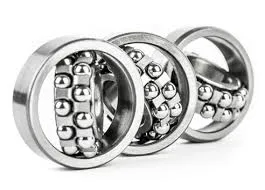
Dec . 03, 2024 15:36 Back to list
thrust ball bearing housing
Thrust Ball Bearing Housing An Overview
Thrust ball bearings play a critical role in various mechanical systems, providing the necessary support for axial loads while allowing rotational movement. As a vital component in many machines, the design and integrity of the thrust ball bearing housing are crucial for the overall performance, durability, and reliability of the equipment in which they are used. This article delves into the significance of thrust ball bearing housing, its design considerations, and its applications.
Understanding Thrust Ball Bearings
Thrust ball bearings consist of two grooved races and a set of balls that sit between these races. They are designed specifically to handle axial loads – forces that act along the axis of the shaft. Unlike radial ball bearings, which accommodate loads perpendicular to the axis, thrust ball bearings ensure stability and support for applications where forces are predominantly axial.
The Importance of Housing
The housing of a thrust ball bearing is an integral part that serves multiple functions. Most importantly, it provides a sturdy structure that holds the bearing in place and aligns it with other components, ensuring smooth operation. The quality and design of the housing can significantly influence the bearing's performance, efficiency, and lifespan.
Key Functions of Thrust Ball Bearing Housing
1. Support and Alignment The housing ensures that the thrust ball bearing is correctly positioned within the machinery, facilitating smooth movement and minimizing wear and tear. 2. Protection The housing shields the bearing from external contaminants, such as dust and moisture, that could cause damage or increase the friction between the bearing surfaces. 3. Heat Dissipation During operation, thrust ball bearings generate heat due to friction. A well-designed housing can help dissipate this heat, preventing overheating and extending the life of the bearing.
4. Ease of Maintenance An efficiently designed housing allows for easier access to the thrust ball bearings for maintenance and replacement, reducing downtime in industrial applications.
Design Considerations
thrust ball bearing housing

When designing a thrust ball bearing housing, several factors must be taken into account to ensure optimal performance
1. Material Selection The housing material should possess sufficient strength to withstand the axial loads and should be resistant to wear and corrosion. Common materials include cast iron, stainless steel, and various engineered plastics.
2. Geometric Design The shape and size of the housing must be carefully considered to ensure compatibility with the thrust ball bearing and the overall system. Precision in machining is crucial for reducing fitment issues and ensuring alignment.
3. Sealing Mechanisms Incorporating effective sealing solutions in the housing design can mitigate contamination risks, enhancing the durability of the thrust ball bearing. Seals can vary from rubber rings to labyrinth seals, depending on the application.
4. Thermal Management The design should allow for adequate airflow or integrate heat-dissipating features, such as fins or cooling channels, to manage the heat generated during operation.
Applications
Thrust ball bearings and their housings are utilized in a myriad of applications across various industries
- Automotive In automobile steering systems, thrust bearings help maintain the positioning of gears and shafts, ensuring smooth steering response. - Aerospace In aircraft engines and landing gear mechanisms, thrust ball bearings support crucial components, providing stability under high axial loads. - Industrial Machinery Manufacturing equipment, conveyors, and cranes often rely on thrust bearings for efficient operation, facilitating load management and motion control. - Marine Applications Thrust bearings in propeller shafts and rudders safeguard against excessive axial loads, ensuring safety and efficiency in marine vessels.
Conclusion
Thrust ball bearing housing is a fundamental element in the functionality of thrust ball bearings, impacting performance, durability, and maintenance ease. By considering factors like material selection, geometric design, sealing mechanisms, and thermal management in the housing design, engineers can enhance the reliability of thrust bearings across diverse applications. As industries evolve and demand more efficient and robust machinery, the importance of high-quality thrust ball bearing housing cannot be overstated.
Latest news
-
Grooved Ball Bearing Design and Functionality
NewsJun.04,2025
-
Concrete Mixer Bearing Load Capacity Testing
NewsJun.04,2025
-
6004 Bearing Dimensions in Robotic Joint Designs
NewsJun.04,2025
-
Advantages of Single-Row Deep Groove Ball Bearings
NewsJun.04,2025
-
Applications of Deep Groove Ball Bearings in Automotive Systems
NewsJun.04,2025
-
Innovations in Bearing Pressing Machine Design
NewsJun.04,2025
